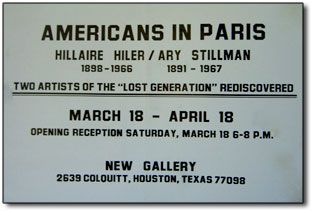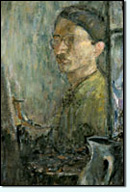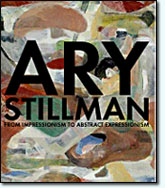Americans in Paris: Hillaire Hiler - Ary Stillman at New Gallery
March 18-April 18, 1989

Visually Speaking
By Ellen Rosenbush Methner
The Jewish Herald-Voice
April, 1989
When the 20th century was learning how to walk, Paris was the pitcher of artistic juice, the well for every thirsty creative thinker. In 1928, the Galerie Bernheim-Jeune held a one-man show of Ary Stillman’s works. The same year George Gershwin wrote and performed An American in Paris. In the 1920s, two American Jewish artists, Ary Stillman and Hillaire Hiler, went to Paris to drink from the wellspring of art.
Their works were on view in “Americans in Paris: Two Artists of the Lost Generation Rediscovered,” an exhibit at the New Gallery, 2639 Colquitt. The show closed Apr. 18, but the ideas expressed in this show have opened doors. New Gallery directors, Thom and Annette Andriola, presented an old idea new. All artists search out inspiration. In the wakening decades of the 20th century, Paris was where you went for a creative infusion. Hiler and Stillman painted there until the threat of Hitler forced them out in the ‘30s. They traveled around the globe in search of the “muse.” Each artist took a sip of inspiration from Taos, New York, and Cuernavaca, Mexico.
Stillman lived and painted in Paris for 12 years. His early Parisian works from the ‘20s-‘30s were impressionistic figure studies or still lifes with a heavy impasto texture. Hiler was a jazz musician at night and a painter by day. When the famous and popular Montparnasse café, “LeJockey,” was ripe with international creative forces, Hiler played the piano there, managed the club for a time and painted murals on the outside of the club. Hiler was embraced by the bohemian enclave of Parisian artists. He knew Picasso, Léger, Breton and Matisse, but he was closest to Man Ray and Stuart Davis. Like Stillman, Hiler’s paintings and drawings are filled with line. Hiler’s line is more subtle and precise than Stillman’s. Comparisons could easily be made to Stuart Davis and Charles Sheeler. Hillaire Hiler was a diverse talent with interests that ranged from color theory, a precisionist form of cubist attraction to theories of the subconscious.
Stillman was also interested in the subconscious. He painted some of the most exciting works waking from dreams, eager to record the images of his mind. His last works have strong outlined shapes in them. Compared to Hiler’s controlled line, Stillman is raw emotion—his line is more powerful and looser than Hiler’s. Ary Stillman’s colors are brilliant stained-glass reds and blues subdued by an overlay of neutral colors. The color layers reverberate like an echo of sound. The abstract linear figures recall the basic primitive shapes of pre-Columbian sculpture or African fertility figures Stillman found in his travels. The figures are reduced to the most basic form. Thom Andriola describes Stillman’s search for form: “he wanted to find the essence, to reach for something primitive and spiritual in his work.”
Prerequisite art historian, H. W. Janson, once described lesser-known artists as “country roads leading to major highways.” The New Gallery rediscovered artists nearly fallen through the cracks of obscurity; artists who may show us the scenic route, not the fast lane of art history. The New Gallery will continue to represent Ary Stillman. A studio visit can be arranged for anyone who is interested in his work. Hillaire Hiler’s works have moved on to New York.
Americans in Paris Exhibit Chronicles Work of 2 Artists
By Susan Chadwick, Post Art Critic
The Houston Post
Monday, April 3, 1989
Hillaire Hiler and Ary Stillman were Americans who lived and painted in Paris during the intoxicating years of the 1920s.
Hiler played jazz piano at night and painted during the day. He was a friend of artists, writers, and musicians such as Django Reinhardt, Aaron Copland, e.e. cummings, Ezra Pound, James Joyce, Henry Miller, Man Ray, Stuart Davis, and many others.
Stillman, born in Russia, was not a part of that group and didn’t know Hiler. While Hiler and other contemporary artists were exploring Cubism and abstraction, Stillman was painting more traditional portraits, still lifes, and landscapes that still showed the influence of Impressionism.
An exhibition of their work, including paintings,
drawings, and photographs, is currently on view at New Gallery,
2639 Colquitt, through April 18. Titled “Americans in Paris:
Hillaire Hiler and Ary Stillman, Two Artists of the Lost Generation
Rediscovered,” the show begins with work from the ‘20s
and ends with work completed just before the death of the two
artists in the mid-60’s.
Stillman, who spent his last years in Houston, died in 1967; by
the time of his death he was doing some of his best work, which
since World War II had become abstract, full of dancing forms
and rhythmic lines.
Recently the Stillman-Lack Foundation of Houston published his memoirs, titled Reminiscences, collected and recorded by his wife, Frances. She still lives here and hopes to establish a museum or find some other suitable venue for the hundreds of paintings and drawings that remain in the possession of the family foundation.
A show of Stillman’s work was organized by the Museum of Fine Arts, Houston, in 1972.
Stillman’s art in the New Gallery is from the collection of the Stillman-Lack foundation, and the Hiler photographs, paintings and drawings are from the Hiler estate. In 1968 the Whitney Museum in New York mounted a retrospective of Hiler’s work.
Hiler was a respected artist in his time, and his work is in many important collections, as is Stillman’s. This show has some interesting historical documents, including a photograph of Hiler with Copland, Pound, Jean Cocteau and a number of other Parisian luminaries. But the work here by Hiler surely is not representative of the talents of the man, who attempted, apparently unsuccessfully, to establish a pseudo-scientific method of painting called “Structuralism.”
There are a few skillful Cubist-inspired and somewhat mystical works on paper that are oddly colored and geometrically patterned renderings of subjects such as American Indians and urban landscapes with swinging, connected lines. However, the later work on view, which is more abstract and reveals a more laborious analysis of color and form, is heavy-handed and uninspired.
Overall, Hiler’s art seems to have surface affinities with the scientific theories of the Neo-Impressionists, and with Orphism and Synchronism, all of which came earlier.
By contrast, Stillman’s earlier oil paintings in this show are nice but unexceptional. But his paintings, gouaches, and drawings continued to improve after his plunge into abstraction in 1945. Having moved back to New York City in 1933, Stillman increasingly sought a deeper source and meaning for his art, especially after the onslaught of World War II.
“He said it was like divers who go down for pearls, but sometimes they don’t come up. He told me ‘I’ve got to be sure to come up from the subconscious,” said Frances Stillman in a recent interview.
His paintings from the 1940s, done in somber, earthy colors, have rhythmic black-line patterns suggesting crowds of figures. Stillman’s dynamic patterns seem to have an intuitive force that comes from within the painting, whereas Hiler’s patterns are more analytical and self-conscious.
In 1957 Stillman and his wife moved to Houston, where they had relatives, but spent most of their time in Cuernavaca, Mexico, where Stillman, “explored the world of fantasy,” said Frances Stillman. His work from this time on took on a pronounced hieroglyphic quality, with active white, gray and black lines freely drawn over patches of bright, naturalistic color.
Suggestive of Mexican Indian wall carvings and often divided into sections of two and four, this poetic late work bears resemblances to the work of the Uruguayan artist Joaquin Torres-Garcia, Adolph Gottlieb, and especially to the meditative calligraphy of Mark Tobey.
Late Artist’s Wife Devoted to His Work
“He never stopped. He was always looking for something else, always dreaming and always seeking,” said Frances Stillman of her late husband, the internationally known painter Ary Stillman.
The Stillmans moved to Houston permanently in 1962, and Frances Stillman lives among hundreds of her husband’s paintings and drawings in a modest apartment not too far from The Summit. A spirited and talented woman in her own right (she graduated from Smith College and was trained as a concert violinist), Frances Stillman’s main concern these days is that her husband’s remaining work, owned by the family Stillman-Lack Foundation, find a suitably visible resting place.
“I want to see that Ary gets the recognition
that he deserved. He was a tip-top painter,” she said. Her
husband, whom she married in 1941 following a five-month romance,
was “not a businessman enough and not opportunistic enough
for that.”
Ary Stillman died in 1967, and in the years that have followed,
his wife has devoted her time to chronicling his life, and cataloging
and placing his artwork. She has maintained a voluminous correspondence
with museums all over the country and has donated or sold artworks
to many of them.
Unable to find work in the all-male symphony orchestras of the time, Frances Stillman’s own unusual career included writing personal letters for Franklin Delano Roosevelt under Louis Howe, the president’s personal secretary, and for Treasury Secretary Henry Morgenthau Jr.
In 1972, the Museum of Fine Arts, Houston, held a retrospective of Ary Stillman’s art. Recently the family foundation published Ary Stillman’s memoirs, Reminiscences, collected and recorded by his wife.
But over 200 paintings, drawings, and prints remain, many of them late works when Ary Stillman seemed to be at the peak of his talent.
“What I would really love is if there could be a little Stillman museum here where the remaining works and memorabilia could be housed,” Frances Stillman said.
“I would love to have Houston know him.
Some Exhibited Artwork Titles:

c. 1960-1966,
gouache on paper,
13 1 9 1/2 in.,
[Private Collection]

c. 1960s,
acrylic on canvas,
[Foundation Collection]




